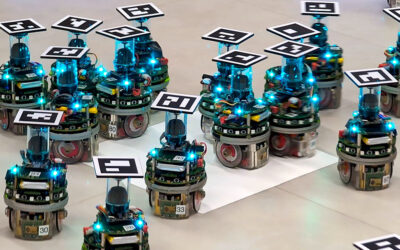Scientists have created a robot that might seem familiar. Inspired by jumping beetles, like weevils and the common flea beetle, this robot can hop — a skill its inventors say makes it especially adept at navigating difficult terrain.
“Jumping beetles rely on the muscles of their legs to stretch the elastic tissue of their legs to store energy during the jump, a mechanism that makes their jumps extremely effective,” said Yanjie Wang who co-authored a paper recently published in Advanced Intelligent Systems.
“In our work, we simulate this jumping mechanism with a robotic skeleton composed of a composite material of carbon fiber and epoxy resin to act as an insect-like energy storage tissue.”
One robot, two forms of locomotion
Named Tumro, the prototype robot measures 320 mm in length and is roughly spool shaped. It has a long, elastic skeleton with an independently driven, 80 mm diameter wheel at either end. Tumro can move in two different ways: crawling and jumping. As it crawls, the robot’s low profile lets it travel under very small spaces; it can also roll over smaller obstacles.
When it encounters an obstacle too large to cross, the robot can be directed to change its posture, turning onto one end while its elastic skeleton transforms from a spool shape to something resembling a Chinese lantern. This shape stores the energy needed to achieve its second form of locomotion.
When the stored energy is released, the robot can jump up to 3 meters, or 40 times its own height. When the robot lands, it can quickly return to its original shape and resume crawling.
Wang said this ability gives it an advantage over single-motion robots. “The single-motion jumping robot has only one movement function of jumping. Even on the flat road surface, it can only move by jumping, which will cause a great waste of energy and reduce the practicality of the robot,” said Wang. “Multi-motion jumping can effectively integrate wheeled motion with jumping, which greatly enhances its practicality and endurance.”
The prototype robot is not autonomous; it requires an operator to tell it when to jump, but because the angle of the jump is fixed, the operator knows exactly where it will land.
“In practical operation, we adjust the robot’s jumping direction by wheel movement,” said Wang. “We plan to make the robot more intelligent in the subsequent improvements so that it has the ability to autonomously overcome obstacles.”
Better jumping, increased versatility
Tumro isn’t the world’s first jumping robot, but Wang said it’s an improvement on existing designs in which the energy storage mechanism is added to the robot rather than being built into the structure itself.
“By integrating the robot skeleton with the energy storage mechanism, we can effectively improve the energy density of the robot during the jumping process,” he said.
Taher Saif, an engineering professor at the Grainger College of Engineering in Urbana, Illinois, who was not involved in the study, said the work seems to represent an important advance in the field of robotics.
“They have achieved a few things, one being a high jump with respect to the body size, and achieving stability,” he said. Giving a high-jumping robot the ability to land upright can be a challenging goal for a design team, Saif said, since the robot may not always fall in exactly the same way.
In their paper, the authors wrote that a robot that can crawl and jump is more practical for working in places where the terrain is rugged and unpredictable. “The crawling-jumping robot exhibits a promising potential for diverse applications, as it demonstrates the capability to navigate through various road conditions utilizing different motion modes,” they wrote.
Wang also said a jumping robot could be a good tool for space exploration, especially on worlds with low gravity. “For the future exploration of exoplanets, low gravity will also greatly enhance the robot jumping effect,” he said.
Saif said he’d be interested in seeing future work demonstrating the scalability of the technology. “Can they go from small to large scale, and what are the consequences?” he said.
He also noted that future robots could have other types of biological motion built into them to make them more agile. “I think in general, the […] robotics community, they’re trying to mimic more and more biological systems behavior,” he said, “and this paper is one step towards that direction.”
Reference: Yanjie Wang, et al., Tumro: A Tunable Multimodal Wheeled Jumping Robot Based on the Bionic Mechanism of Jumping Beetles, Advanced Intelligent Systems, (2024). DOI: 10.1002/aisy.202400024

















